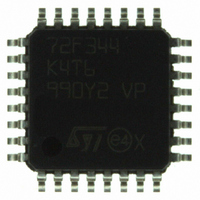ST72F344K4T6 STMicroelectronics, ST72F344K4T6 Datasheet - Page 239

ST72F344K4T6
Manufacturer Part Number
ST72F344K4T6
Description
MCU 8BIT 16KB FLASH MEM 32-LQFP
Manufacturer
STMicroelectronics
Series
ST7r
Datasheet
1.ST72F344K2T6.pdf
(247 pages)
Specifications of ST72F344K4T6
Core Processor
ST7
Core Size
8-Bit
Speed
8MHz
Connectivity
I²C, LIN, SCI, SPI
Peripherals
LVD, POR, PWM, WDT
Number Of I /o
24
Program Memory Size
16KB (16K x 8)
Program Memory Type
FLASH
Eeprom Size
256 x 8
Ram Size
1K x 8
Voltage - Supply (vcc/vdd)
2.7 V ~ 5.5 V
Data Converters
A/D 12x10b
Oscillator Type
Internal
Operating Temperature
-40°C ~ 85°C
Package / Case
32-LQFP
Processor Series
ST72F3x
Core
ST7
Data Bus Width
8 bit
Data Ram Size
1 KB
Interface Type
I2C, SCI, SPI
Maximum Clock Frequency
8 MHz
Number Of Programmable I/os
34
Number Of Timers
2
Maximum Operating Temperature
+ 85 C
Mounting Style
SMD/SMT
Development Tools By Supplier
ST72F34X-SK/RAIS, ST7MDT40-EMU3, STX-RLINK
Minimum Operating Temperature
- 40 C
On-chip Adc
10 bit, 8 Channel
For Use With
497-5046 - KIT TOOL FOR ST7/UPSD/STR7 MCU
Lead Free Status / RoHS Status
Lead free / RoHS Compliant
Other names
497-5611
Available stocks
Company
Part Number
Manufacturer
Quantity
Price
Company:
Part Number:
ST72F344K4T6
Manufacturer:
STMicroelectronics
Quantity:
10 000
Company:
Part Number:
ST72F344K4T6TR
Manufacturer:
STMicroelectronics
Quantity:
10 000
ST72344xx ST72345xx
16
16.1
16.1.1
Known limitations
External interrupt missed
To avoid any risk if generating a parasitic interrupt, the edge detector is automatically
disabled for one clock cycle during an access to either DDR and OR. Any input signal edge
during this period will not be detected and will not generate an interrupt.
This case can typically occur if the application refreshes the port configuration registers at
intervals during runtime.
Workaround
The workaround is based on software checking the level on the interrupt pin before and after
writing to the PxOR or PxDDR registers. If there is a level change (depending on the
sensitivity programmed for this pin) the interrupt routine is invoked using the call instruction
with three extra PUSH instructions before executing the interrupt routine (this is to make the
call compatible with the IRET instruction at the end of the interrupt service routine).
But detection of the level change does not make sure that edge occurs during the critical 1
cycle duration and the interrupt has been missed. This may lead to occurrence of same
interrupt twice (one hardware and another with software call).
To avoid this, a semaphore is set to '1' before checking the level change. The semaphore is
changed to level '0' inside the interrupt routine. When a level change is detected, the
semaphore status is checked and if it is '1' this means that the last interrupt has been
missed. In this case, the interrupt routine is invoked with the call instruction.
There is another possible case i.e. if writing to PxOR or PxDDR is done with global
interrupts disabled (interrupt mask bit set). In this case, the semaphore is changed to '1'
when the level change is detected. Detecting a missed interrupt is done after the global
interrupts are enabled (interrupt mask bit reset) and by checking the status of the
semaphore. If it is '1' this means that the last interrupt was missed and the interrupt routine
is invoked with the call instruction.
To implement the workaround, the following software sequence is to be followed for writing
into the PxOR/PxDDR registers. The example is for Port PF1 with falling edge interrupt
sensitivity. The software sequence is given for both cases (global interrupt
disabled/enabled).
Case 1: Writing to PxOR or PxDDR with global interrupts enabled:
LD A,#01
LD sema,A; set the semaphore to '1'
LD A,PFDR
AND A,#02
LD
LD A,#$90
LD PFDDR,A; Write to PFDDR
LD A,#$ff
LD
X,A; store the level before writing to PxOR/PxDDR
PFOR,A; Write to PFOR
Doc ID 12321 Rev 5
Known limitations
239/247













